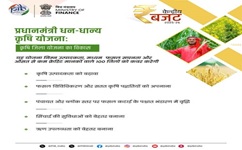21 September, 2025
Approval of Pradhan Mantri Dhan-Dhaanya Krishi Yojana (PMDKY)
Thu 17 Jul, 2025
CONTEXT :
- The Cabinet Committee on Economic Affairs (CCEA), chaired by Prime Minister Narendra Modi, has approved the launch of the Pradhan Mantri Dhan-Dhaanya Krishi Yojana (PMDKY).
Key Highlights
Objective:
- To enhance agricultural productivity, promote crop diversification, and adopt sustainable farming practices
- Strengthen post-harvest storage infrastructure at panchayat and block levels
- Improve irrigation facilities
- Ensure easy access to short-term and long-term agricultural credit
Target:
- Comprehensive development of 100 selected agricultural districts
- Focus on districts with low productivity, aiming to strengthen their rural economy
Timeline & Financial Allocation
- Duration: 6 years (from 2025–26 to 2030–31)
- Annual Budget Allocation: ₹24,000 crore per year
Main Strategies
- Integration of 36 existing schemes from 11 different ministries, including those related to agriculture, irrigation, seeds, research, insurance, etc.
- Designed on the lines of the Aspirational Districts Programme
Selection Criteria & Scope
- Indicators for District Selection:
-
- Low agricultural productivity
- Low cropping intensity
- Low distribution of agricultural credit
- District Selection:
-
- At least 1 district from each state/UT
- Maximum districts selected based on cropping intensity and agricultural area
Implementation Framework
- Three-tier Committee System: At national, state, and district levels
- District Dhan Dhaanya Samiti to be formed in every district
- Agricultural universities will act as technical partners
- Monthly monitoring through a digital dashboard tracking 117 Key Performance Indicators (KPIs)
- NITI Aayog to provide strategic guidance and periodic reviews
Core Components
- Enhancing crop yield
- Crop diversification and sustainable agriculture
- Post-harvest storage infrastructure at panchayat/block level
- Improvement in irrigation systems
- Easy access to credit
- Soil and water health preservation
- Technology transfer via corporate and private sector partnerships
Beneficiaries & Expected Outcomes
- Estimated 1.7 crore (17 million) farmers to benefit each year
Expected Impact:
- Increase in productivity and income
- Improvement in rural employment
- Promotion of a self-reliant and sustainable agricultural model
- Strengthening of food security and contribution to economic growth
Major Government Initiatives to Enhance Agricultural Productivity
| Scheme/Policy | Launch Year | Objective / Key Components |
| National Food Security Mission (NFSM) | 2007–08 | Sustainable increase in production of rice, wheat, pulses, coarse cereals, oilseeds & millets |
| Pradhan Mantri Krishi Sinchayee Yojana | 2015 | Expand irrigation coverage (“Har Khet Ko Pani”), increase water-use efficiency (“More Crop per Drop”) |
| PM-KISAN Scheme | 2019 | Direct income support of ₹6,000/year in three installments to eligible farmers |
| Agriculture Infrastructure Fund | 2020–21 | Medium/long-term credit for post-harvest management & community farm assets |
| MSP Hike (A2+FL x 1.5) | 2018–19 | Increase in Minimum Support Prices to ensure at least 50% profit over production cost |
| Kisan Credit Card (KCC) Scheme | 1998 (expanded in 2019) | Easy & affordable credit; now also includes animal husbandry, dairy & fisheries |
| PM Fasal Bima Yojana (Crop Insurance) | 2016 | Insurance coverage for crops against natural calamities, pests, and diseases |
| Nutrient-Based Subsidy (NBS) Policy | 2010 | Balanced fertilizer usage and soil health improvement through nutrient-based subsidies |


















